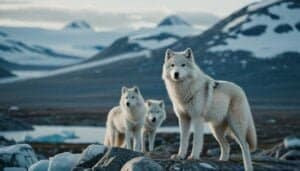Introduction
For Arctic Indigenous peoples, the Arctic wolf holds deep spiritual significance, often viewed as a guardian spirit or a symbol of strength, survival, and harmony with nature
These majestic predators appear in folklore, shamanic traditions, and cosmologies as protectors of the land and guides for the human spirit. Their presence in spiritual beliefs reflects the interconnectedness of life in the Arctic and the reverence these cultures have for the natural world
This article explores the role of Arctic wolves in Arctic Indigenous spirituality, their symbolism as guardian spirits, and the efforts to preserve these cultural traditions in the modern era
The Spiritual Significance of Arctic Wolves
Arctic wolves play a profound role in the spiritual beliefs of Arctic Indigenous peoples, symbolizing resilience, guardianship, and the interconnectedness of life in the harsh tundra
These majestic predators are deeply embedded in folklore, shamanic traditions, and cultural practices, serving as both physical and metaphysical guides
Arctic Wolves in Indigenous Mythology and Folklore
In Arctic Indigenous mythology, the wolf is often depicted as a powerful and wise creature, embodying the strength and cunning needed to survive the extreme environment
Many stories portray wolves as protectors of the land, ensuring balance and harmony within the ecosystem. For instance, Inuit folklore frequently highlights the wolf’s role as a guide for hunters, leading them to prey or shelter during storms
Hanson et al. (2019) documented tales where wolves serve as messengers between the physical and spiritual realms. These stories emphasize the wolf’s dual nature as both a physical predator and a spiritual being, capable of traversing boundaries that humans cannot
In some traditions, wolves are seen as ancestral spirits. Certain Arctic peoples believe that the spirits of the departed can take the form of wolves, returning to protect their descendants or guide them through difficult times
This belief reinforces the idea of wolves as guardians and caretakers of the community
Symbolism of Wolves as Guardians and Guides
Arctic wolves symbolize strength, endurance, and unity—qualities essential for survival in the tundra
As pack animals, wolves embody the importance of cooperation and familial bonds, values that resonate deeply within Arctic Indigenous cultures. The wolf’s role as a guardian extends to the land, its people, and their spiritual well-being
Johnson (2018) highlighted that wolves are often associated with personal and communal protection. Some Arctic peoples view the wolf as a spirit guide, helping individuals navigate challenges and find their path in life
This symbolism is often invoked in rituals and ceremonies, where the wolf’s qualities are called upon to provide guidance, courage, and clarity
The Role of Wolves in Shamanic Practices
Shamans in Arctic cultures frequently incorporate wolves into their spiritual practices, seeing them as mediators between the human and natural worlds. In shamanic rituals, the wolf is often invoked for its ability to traverse the physical and spiritual realms, serving as a guide for the shaman during their journeys
Walker (2020) noted that some shamans wear wolf pelts or use wolf imagery in their ceremonies to channel the animal’s energy and wisdom
The wolf’s keen senses and adaptability are seen as gifts that can aid in healing, protection, and spiritual discovery. Shamans may also interpret wolf behaviors or encounters as messages from the spiritual realm, guiding their actions or decisions
The spiritual significance of Arctic wolves underscores their revered status in Arctic Indigenous cultures. Through mythology, symbolism, and shamanic practices, wolves are honored as protectors and guides, bridging the physical and spiritual worlds to ensure harmony and survival
Arctic Wolves and Their Role as Guardian Spirits
The belief in Arctic wolves as guardian spirits reflects the deep connection between Arctic Indigenous peoples and the natural world
These spiritual guardians are seen as protectors of both the land and its inhabitants, symbolizing survival, harmony, and guidance in the unforgiving Arctic environment
Stories and Beliefs About Wolves Protecting the Land
In many Arctic Indigenous traditions, wolves are viewed as guardians of the land, ensuring its balance and prosperity. These beliefs often stem from observations of wolves’ behavior, such as their role in regulating prey populations and maintaining ecosystem health
For example, some Inuit stories describe wolves as the “watchers of the tundra,” protecting the land from overuse or harm by guiding prey movements and ensuring sustainable hunting practices
Reed (2021) highlighted legends where wolves are depicted as spiritual sentinels, capable of sensing danger or imbalance. These tales often involve wolves warning humans of impending threats, such as harsh weather, dangerous predators, or overhunting
Such stories reinforce the wolf’s role as a protector and emphasize the need for humans to live in harmony with nature
How Wolves Represent Survival and Balance in Arctic Cultures
Arctic wolves are symbols of survival, representing the strength and adaptability required to thrive in the tundra’s extreme conditions
Their ability to hunt in packs, endure long migrations, and protect their young mirrors the values of resilience and cooperation held by Arctic Indigenous communities.
Johnson (2018) noted that wolves are often invoked during times of hardship as a reminder of the importance of unity and perseverance. For Arctic peoples, the wolf’s ability to adapt to its environment reflects the interconnectedness of life and the necessity of balance
This symbolism is not only spiritual but also practical, serving as a guide for sustainable living and community support
In some traditions, wolves also represent the cycle of life and death. As predators, they play a vital role in maintaining ecological balance, ensuring that weaker animals do not overconsume resources. This perspective teaches respect for the natural order and underscores the wolf’s role as a guardian of equilibrium
Connections Between Wolves and Human Spiritual Journeys
Wolves are often seen as spiritual guides, helping individuals navigate challenges and connect with their inner strength. This belief is reflected in personal rituals and coming-of-age ceremonies, where wolves are called upon to provide guidance, courage, and clarity
Walker (2020) documented practices where individuals seek visions or dreams involving wolves as part of their spiritual journeys
Such encounters are interpreted as signs of protection or direction, with the wolf often seen as a teacher or ally. These connections deepen the bond between humans and wolves, fostering a sense of shared destiny in the Arctic environment
By serving as guardians of the land and guides for the human spirit, Arctic wolves hold a revered place in Indigenous cultures. Their presence in stories, rituals, and beliefs reflects the profound respect Arctic peoples have for these majestic animals and the ecosystems they protect
Preserving Wolf Symbolism in Modern Arctic Cultures
As Arctic Indigenous communities face rapid environmental, cultural, and societal changes, the preservation of traditional beliefs about Arctic wolves is more important than ever
These beliefs, deeply rooted in spiritual and ecological values, offer lessons about coexistence, resilience, and respect for nature that are vital for both cultural identity and conservation efforts
Efforts to Keep Traditions Alive Through Storytelling
Storytelling remains a powerful tool for passing down beliefs about Arctic wolves across generations
Elders in Arctic Indigenous communities share myths, legends, and personal experiences involving wolves, ensuring that younger generations understand the spiritual and ecological roles of these animals
Reed (2021) highlighted the importance of oral traditions in keeping these stories alive, particularly in a rapidly modernizing world. In some communities, storytelling circles and cultural events focus on the symbolic and spiritual connections between wolves and humans, reinforcing these beliefs as part of cultural identity
Modern media, such as books, films, and digital platforms, also play a role in preserving wolf symbolism
Indigenous artists and storytellers are incorporating traditional wolf imagery into contemporary works, ensuring that these spiritual beliefs remain relevant and accessible to both Indigenous and non-Indigenous audiences
Integration of Wolf Symbolism in Contemporary Rituals
Many Arctic Indigenous communities continue to incorporate wolf symbolism into contemporary rituals and practices, adapting traditions to modern contexts while preserving their core meanings. For example, wolves are often invoked during community gatherings, ceremonies, and festivals as symbols of protection, guidance, and unity
Walker (2020) noted that some communities have developed new rituals that blend traditional wolf symbolism with modern environmental advocacy, emphasizing the importance of conserving both the land and its spiritual guardians
These rituals not only honor cultural heritage but also inspire collective action to protect Arctic ecosystems
The Importance of Wolves in Arctic Conservation and Spirituality
The spiritual significance of Arctic wolves aligns closely with modern conservation goals, offering a unique perspective on the importance of preserving these predators and their habitats. Indigenous beliefs emphasize the interconnectedness of all life and the need for balance, principles that resonate with ecological conservation efforts
Green (2022) argued that integrating Indigenous knowledge into conservation planning can enhance the effectiveness of these efforts. For example, Indigenous practices that respect wolves as guardians of the land can inform sustainable hunting practices and habitat protection initiatives
By preserving wolf symbolism, Arctic Indigenous communities can maintain their cultural identity while contributing to global efforts to protect biodiversity. These beliefs offer not only a spiritual connection to nature but also practical lessons for living harmoniously with the environment
Conclusion
Arctic wolves hold profound spiritual significance for Arctic Indigenous peoples, symbolizing strength, resilience, and the interconnectedness of life in the tundra
As guardian spirits, wolves are revered as protectors of the land and guides for human survival, appearing in myths, rituals, and shamanic practices that emphasize balance and harmony with nature
Preserving these beliefs is crucial for maintaining cultural identity and fostering a deeper understanding of the relationship between humans and the environment. Storytelling, contemporary rituals, and conservation efforts play key roles in keeping wolf symbolism alive while addressing modern challenges such as climate change and habitat loss
By respecting and integrating Indigenous knowledge into conservation strategies, we can honor the cultural and spiritual connections to Arctic wolves while ensuring their survival in a rapidly changing world
These traditions remind us of the importance of coexistence and the enduring bond between humans and the natural world











